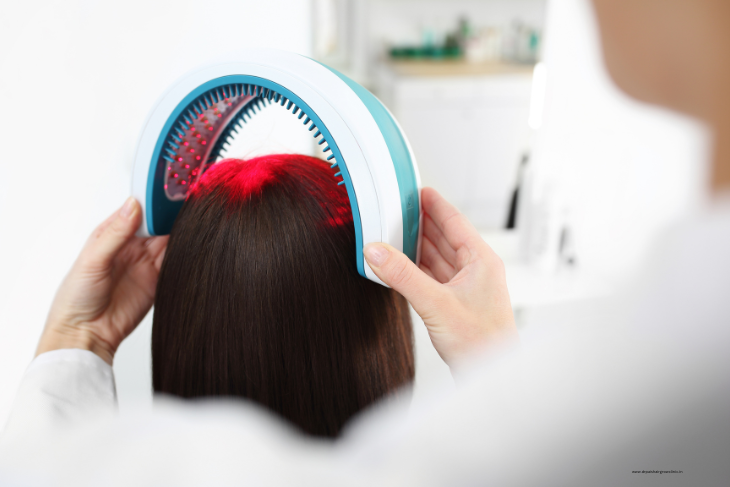
Hair loss is a common concern affecting millions of people worldwide. Losing hair can significantly impact one's confidence and self-esteem, whether due to genetics, hormonal changes, aging, or medical conditions. Fortunately, advancements in hair restoration technologies have introduced effective, non-invasive treatments. One such promising method is Laser Therapy (LLLT), which has gained recognition for stimulating hair growth and improving scalp health without surgery or medications.
What is Low-Level Laser Therapy (LLLT)
LLLT, also known as red light therapy or cold laser therapy, is an innovative therapy that uses low-power lasers or light-emitting diodes (LEDs) to stimulate hair follicles, improve blood circulation, and promote hair regrowth. Unlike surgical hair restoration procedures, LLLT is painless, requires no downtime, and is considered a safe option for individuals experiencing hair thinning or pattern baldness.
How LLLT Works to Combat Hair Loss
1.Improved Blood Circulation
LLLT enhances blood flow to the scalp, ensuring that hair follicles receive the essential nutrients and oxygen needed for optimal growth.
2.Cellular Stimulation
By increasing ATP production, LLLT helps revitalize weak or dormant hair follicles, encouraging new hair growth.
3.Reduction of Inflammation
Many cases of hair loss are associated with inflammation, which can damage follicles. LLLT has anti-inflammatory properties that create a favorable environment for hair regrowth.
4.Prolonged Hair Growth Phase
LLLT extends the anagen (growth) phase of the hair cycle, reducing excessive hair shedding and promoting fuller, thicker hair over time.
5.Safe and Painless Treatment
Unlike invasive procedures, LLLT is non-surgical and completely pain-free, making it a viable option for individuals looking for a gentle yet effective solution to hair loss.
Who Can Benefit from LLLT?
LLLT is an effective treatment option for individuals experiencing different types of hair loss, including:
- Androgenetic Alopecia (Male and Female Pattern Baldness): LLLT has been proven to slow down hair loss and promote new growth in people with genetic hair thinning.
- Telogen Effluvium: People suffering from temporary hair shedding due to stress, illness, or hormonal changes can benefit from LLLT as it stimulates the follicles back into the growth phase.
- Post-Hair Transplant Patients: Many doctors recommend LLLT after hair transplant surgery to accelerate healing, reduce shock loss, and improve overall graft survival.
- Individuals with Thinning Hair: Anyone noticing early signs of hair thinning can use LLLT as a preventative measure to strengthen their existing hair and maintain scalp health.
LLLT Treatment Methods
There are several ways to undergo LLLT treatment, depending on the severity of hair loss and individual preferences:
- In-Clinic LLLT Sessions: Many dermatology and hair restoration clinics offer professional LLLT treatments using high-powered laser devices. These sessions are typically conducted under the supervision of trained specialists.
- Laser Caps and Helmets: FDA-approved at-home laser therapy devices, such as laser caps and helmets, allow users to undergo treatment in the comfort of their homes. These portable devices are designed to be worn for a few minutes per day, making them convenient for long-term use.
- Laser Combs and Brushes: Handheld LLLT devices like laser combs and brushes offer targeted laser exposure to the scalp. They are more affordable than caps or in-clinic treatments but require manual application.
What to Expect from LLLT Treatment
LLLT is a gradual process, and results vary from person to person. However, most users can expect the following timeline:
- 0-3 Months: Minimal visible changes. The scalp begins to show increased blood circulation, and shedding may temporarily increase as weak hairs make way for new growth.
- 3-6 Months: Noticeable improvement in hair texture and density. Hair shedding decreases, and new hair strands start appearing.
- 6-12 Months: Fuller, thicker hair with improved scalp coverage. Many users report a significant boost in hair growth and overall scalp health.
- Beyond 12 Months: Continued maintenance treatments are recommended to sustain hair growth and prevent future thinning.
Potential Side Effects and Considerations
LLLT is widely regarded as a safe treatment with minimal risks. However, some users may experience:
- Mild scalp irritation or sensitivity
- Temporary increased shedding as weak hairs are replaced with new growth
- Lack of significant results in advanced stages of baldness (LLLT works best for early to moderate hair loss)
It is crucial to consult with a hair restoration specialist or dermatologist before starting LLLT to determine if it's the right treatment for your specific hair loss condition.
Combining LLLT with Other Hair Loss Treatments
For optimal results, LLLT can be combined with other hair restoration therapies, including:
- Topical Minoxidil (Rogaine): Enhances hair regrowth by prolonging the anagen phase.
- Platelet-Rich Plasma (PRP) Therapy: Stimulates follicles with growth factors derived from the patient’s blood.
- Oral Medications (Finasteride for Men): Helps slow down hair loss progression by blocking DHT, the hormone responsible for genetic baldness.
- Nutritional Supplements (Biotin, Zinc, and Vitamin D): Support hair follicle health and improve overall hair quality.
Conclusion: Is LLLT Worth It?
Low-Level Laser Therapy (LLLT) has emerged as a revolutionary, non-invasive treatment for hair loss that offers promising results with minimal risks. Whether used alone or in combination with other therapies, LLLT provides an effective way to stimulate hair growth, reduce hair shedding, and enhance overall scalp health.
For individuals seeking a safe, painless, and scientifically backed solution to hair thinning, LLLT is worth considering. However, consistency and patience are key, as noticeable results take time. If you're struggling with hair loss and looking for a long-term solution, consult with a hair specialist at Dr Pai’s Clinic to determine if LLLT is the right fit for you.
Contact Us
